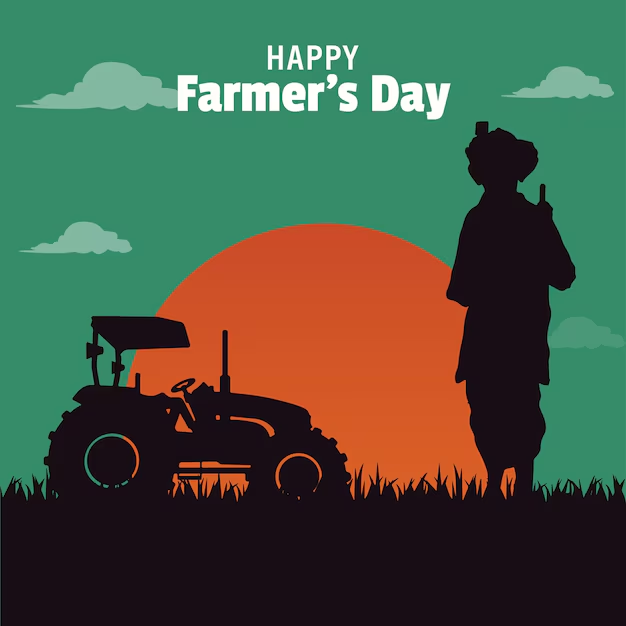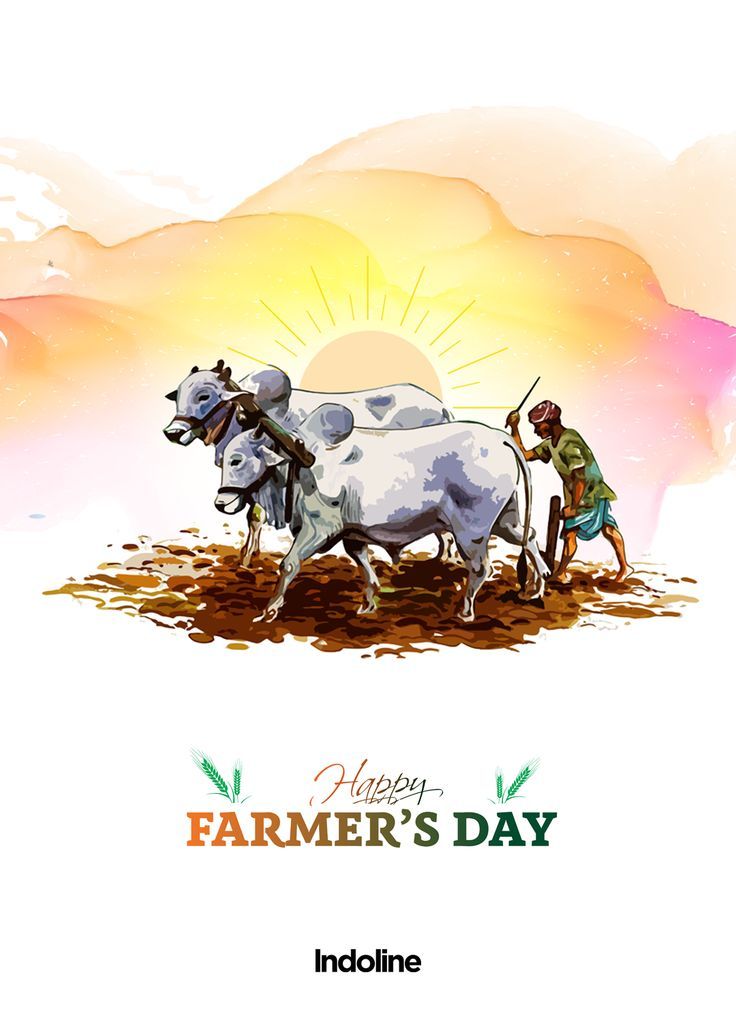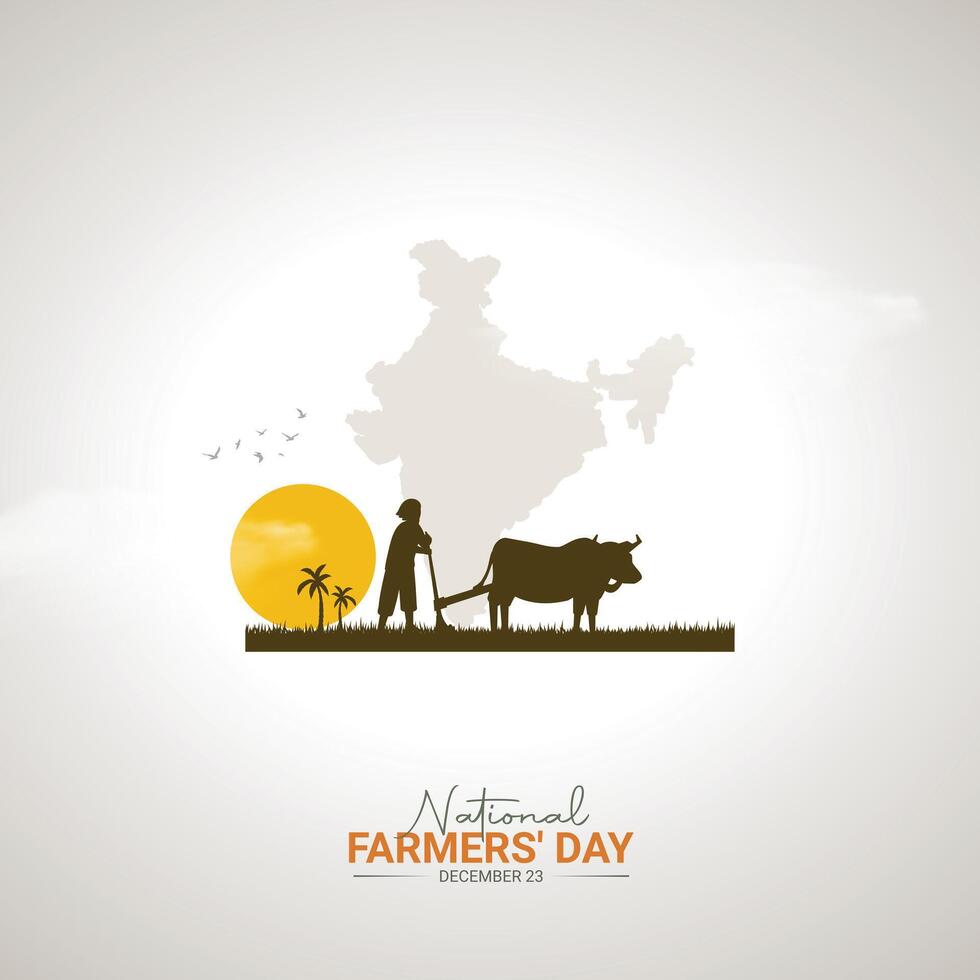
Table of Contents
Farmers’ Day: Honoring the Backbone of Our Nation
Introduction

Farmers’ Day, also known as Kisan Diwas, is a tribute to the relentless efforts of farmers who play a crucial role in sustaining human life and driving economic progress. Observed in various countries on different dates, this special day highlights the indispensable role of agriculture in feeding the world, generating employment, and maintaining ecological balance.
Agriculture is not just an industry; it is a way of life that has shaped civilizations for centuries. Farmers work tirelessly, often braving unpredictable weather conditions, market fluctuations, and numerous challenges to ensure that food reaches our tables. Their dedication ensures food security, supports rural economies, and contributes to the overall well-being of society.
Farmers’ Day serves as a powerful reminder of their perseverance and sacrifices. It is a time to acknowledge their contributions, raise awareness about the issues they face, and encourage policies that support sustainable farming practices. By celebrating this day, we express gratitude to the backbone of our nation and reaffirm our commitment to agricultural progress and farmer welfare.
Through various initiatives, discussions, and appreciation events, Farmers’ Day emphasizes the importance of innovation in agriculture, fair trade policies, and modern farming techniques to enhance productivity while preserving natural resources. It is an opportunity to unite in honoring those who work tirelessly to nourish the world, ensuring a brighter future for all.
History and Significance of Farmers’ Day
Farmers’ Day is celebrated in different countries worldwide, each choosing a date that aligns with its agricultural heritage, policies, and historical figures who have contributed significantly to farming and rural development. This special day is dedicated to recognizing the hard work, resilience, and invaluable contributions of farmers, who are the backbone of food production and economic stability.
Farmers’ Day in India – December 23rd
In India, Kisan Diwas (Farmers’ Day) is observed on December 23rd to honor the birth anniversary of Chaudhary Charan Singh, the fifth Prime Minister of India. A staunch advocate for farmers’ rights, Chaudhary Charan Singh implemented numerous land reforms and policies aimed at improving the conditions of small and marginal farmers. His efforts focused on eradicating landlordism, promoting cooperative farming, and ensuring fair prices for agricultural produce. His leadership and vision earned him immense respect among the farming community, making December 23rd a day of tribute to his contributions.
On this day, various programs, seminars, and awareness campaigns are organized across India to educate farmers about modern farming techniques, government schemes, and sustainable agricultural practices. Awards and recognitions are also given to outstanding farmers who have made significant contributions to the field of agriculture.
Farmers’ Day in the United States – October 12th
In the United States, National Farmers’ Day is observed on October 12th as a tribute to the vital role farmers play in feeding the nation and sustaining the economy. The history of this observance dates back to the early 1800s, when agriculture was the primary occupation for most Americans. The day serves as a reminder of the dedication, innovation, and challenges faced by farmers, who work tirelessly to maintain the country’s food supply chains.
Events such as farm fairs, community gatherings, and educational programs are organized to celebrate the contributions of farmers and to encourage support for local and sustainable farming. Schools and agricultural institutions also use this opportunity to raise awareness about modern farming challenges, including climate change, soil conservation, and technological advancements in agriculture.
Farmers’ Day in Other Countries
- Ghana – Farmers’ Day is a national holiday celebrated on the first Friday of December to recognize the hard work of farmers and fishermen in boosting the country’s agricultural sector. Established in 1985, the day includes awards for the Best Farmer of the Year and discussions on enhancing food security.
- Zambia – Observed on the first Monday of August, Farmers’ Day in Zambia highlights the contributions of the agricultural sector to economic development. The day is marked by agricultural exhibitions, fairs, and discussions on improving farming productivity.
- Vietnam – Vietnam celebrates National Farmers’ Day on October 14th, recognizing the importance of rural development and encouraging policies that support farmers in achieving self-sufficiency and economic growth.
- South Korea – Farmers’ Day, observed on November 11th, focuses on the advancement of agricultural technology and appreciation for rural workers who contribute to national food security.
Global Recognition of Farmers’ Contributions
While the dates and traditions vary, the essence of Farmers’ Day remains the same across the world—to honor those who cultivate the land, ensure food security, and support economies through agriculture. The agricultural sector faces numerous challenges, including climate change, water scarcity, fluctuating market prices, and labor shortages. Farmers’ Day serves as an occasion to not only celebrate their efforts but also to highlight the need for agricultural reforms, investment in sustainable farming, and support for rural communities.
By recognizing and appreciating farmers, society acknowledges their tireless dedication and invaluable role in ensuring that food reaches our tables, economies remain stable, and rural communities thrive.

The Role of Farmers in Society
Farmers play a fundamental role in shaping society by ensuring food security, driving economic progress, and contributing to environmental sustainability. Their contributions go beyond cultivating crops and raising livestock; they also help preserve cultural traditions and adapt to modern technological advancements in agriculture.
1. Food Production and Security
One of the primary responsibilities of farmers is to produce food for the growing global population. They cultivate a wide variety of crops, including grains, fruits, and vegetables, as well as raise livestock for meat, dairy, and eggs. By employing advanced agricultural techniques such as precision farming, hydroponics, and genetically modified crops, farmers enhance productivity and efficiency, ensuring a stable and sufficient food supply.
2. Economic Growth and Employment
Agriculture is a major driver of economic development, particularly in rural areas. Farmers contribute to national economies by generating income through the sale of crops, livestock, and dairy products. Additionally, the agricultural sector creates millions of jobs, directly employing farmworkers and indirectly supporting industries such as food processing, transportation, and retail. Agribusiness and exports also help strengthen trade and economic stability in many nations.
3. Environmental Conservation and Sustainability
Many farmers implement eco-friendly and sustainable farming practices to protect natural resources. Techniques such as crop rotation, organic farming, and conservation tillage help maintain soil fertility and prevent erosion. Moreover, sustainable irrigation and water management strategies conserve water resources, while afforestation and agroforestry practices contribute to biodiversity and climate change mitigation.
4. Cultural Preservation and Traditional Knowledge
Agriculture has deep cultural roots, with farming traditions and techniques passed down through generations. Many indigenous communities rely on traditional farming methods that emphasize harmony with nature and biodiversity preservation. By continuing these practices, farmers help maintain cultural heritage and contribute to sustainable agricultural systems that have been effective for centuries.
5. Innovation and Technological Advancements
Modern agriculture is increasingly driven by innovation, with farmers adopting smart technologies to enhance productivity. Drones, AI-powered monitoring systems, and automated machinery help optimize resource use and reduce waste. Biotechnology and sustainable pest control methods further support increased yields while minimizing environmental impact. These innovations not only improve efficiency but also help meet the rising demand for food in an ever-growing population.
Challenges Faced by Farmers: Struggles in Sustaining Agriculture
Despite being the backbone of the economy and ensuring food security, farmers worldwide face numerous challenges that threaten their productivity, financial stability, and overall well-being. These challenges arise from various environmental, economic, and societal factors, making farming a highly unpredictable and strenuous profession.
1. Climate Change and Environmental Challenges
Farmers are increasingly affected by unpredictable climate patterns, which directly impact agricultural productivity.
- Unseasonal Rains and Droughts: Excessive rainfall leads to crop damage, while prolonged droughts reduce water availability for irrigation.
- Soil Degradation: Overuse of chemical fertilizers, deforestation, and erosion reduce soil fertility, making it difficult to sustain long-term farming.
- Pest and Disease Outbreaks: Climate change has led to an increase in crop diseases and pest attacks, affecting yield and quality.
2. Financial Struggles and Debt Burden
Many farmers, especially small-scale ones, struggle with financial instability due to various reasons:
- High Input Costs: The cost of seeds, fertilizers, pesticides, and equipment is often high, reducing profitability.
- Low Selling Prices: Farmers often sell their produce at lower-than-expected prices due to market fluctuations and middlemen.
- Limited Access to Credit: Many farmers rely on informal lenders with high-interest rates due to the lack of accessible financial support.
- Crop Loss and Insurance Gaps: Inadequate agricultural insurance schemes leave farmers vulnerable to losses from natural disasters.
3. Limited Access to Modern Technology
The lack of modern technology significantly affects farm productivity and efficiency.
- Traditional Farming Methods: Many farmers still use age-old techniques that result in lower yields compared to mechanized farming.
- Limited Irrigation Facilities: A significant portion of agricultural land depends on monsoons, making irrigation facilities crucial but often unavailable.
- Lack of Awareness and Training: Farmers may not have the necessary knowledge to adopt new farming technologies and techniques.
4. Market Fluctuations and Unstable Prices
Agricultural markets are highly volatile, often leading to uncertainty and financial distress for farmers.
- Fluctuating Demand and Supply: An oversupply of crops can crash prices, while a poor harvest may lead to inflation.
- Exploitation by Middlemen: Many farmers do not have direct access to markets and are forced to sell at lower prices to intermediaries.
- Lack of Fair Trade Policies: Unequal bargaining power in the supply chain prevents farmers from getting fair compensation for their produce.
5. Land Scarcity and Rapid Urbanization
Urban expansion and industrialization are gradually reducing the availability of fertile land for agriculture.
- Loss of Arable Land: Many fertile farmlands are being converted into residential or commercial spaces, reducing farming areas.
- Small and Fragmented Land Holdings: Due to inheritance divisions, farm sizes are shrinking, making large-scale farming difficult.
- Encroachment and Land Disputes: Many farmers struggle with land ownership issues, further affecting agricultural output.
Government Initiatives and Support for Farmers
To strengthen the agricultural sector and ensure the well-being of farmers, governments across the world have launched various schemes, subsidies, and policies aimed at promoting sustainable agriculture, financial stability, and technological advancement. These initiatives not only help reduce farming costs but also mitigate risks, improve productivity, and ensure fair market access.
1. Subsidies and Financial Aid
One of the primary ways governments support farmers is by offering financial assistance and subsidies to help them cope with rising costs and increase productivity. These include:
- Seed & Fertilizer Subsidies – Providing farmers with high-quality seeds, organic fertilizers, and pesticides at subsidized rates to enhance crop yield.
- Equipment & Machinery Support – Schemes that promote mechanization in agriculture, allowing farmers to purchase tractors, plows, and irrigation pumps at discounted prices or through low-interest loans.
- Interest-Free & Low-Interest Loans – Programs like the Kisan Credit Card (KCC) in India offer farmers access to affordable credit, ensuring they have the necessary funds for agricultural operations.
- Minimum Support Price (MSP) – Governments in various countries, including India and the U.S., set a minimum price for crops, ensuring farmers receive fair compensation despite market fluctuations.
2. Irrigation and Water Management Projects
Access to reliable irrigation is crucial for consistent agricultural output. To combat water scarcity and improve water efficiency, governments invest in:
- Irrigation Infrastructure Development – Building canals, reservoirs, and drip irrigation systems to optimize water use and prevent wastage.
- Micro-Irrigation Schemes – Encouraging drip and sprinkler irrigation to conserve water while maximizing crop yield. In India, the Pradhan Mantri Krishi Sinchayee Yojana (PMKSY) aims to expand irrigation coverage.
- Rainwater Harvesting & Watershed Development – Projects that focus on storing and efficiently utilizing rainwater, especially in drought-prone regions.
3. Crop Insurance Schemes
Farming is highly dependent on natural conditions, making farmers vulnerable to climate change, unpredictable weather, and natural disasters. To reduce financial risks, governments have launched insurance programs that provide compensation for crop losses. Some key examples include:
- Pradhan Mantri Fasal Bima Yojana (PMFBY) – India – Covers crop loss due to droughts, floods, pests, and diseases, ensuring farmers don’t suffer heavy financial setbacks.
- Federal Crop Insurance Program – USA – Protects American farmers against yield losses and price fluctuations, covering over 100 crops.
- Agricultural Risk Coverage (ARC) & Price Loss Coverage (PLC) – USA – These programs provide financial aid if crop revenue or market prices fall below guaranteed levels.
- European Union Agricultural Insurance Schemes – Supports farmers facing climate risks by offering subsidies on crop insurance premiums.
4. Training and Education in Agriculture
Modern agriculture relies on scientific advancements, data-driven techniques, and climate-smart farming practices. To equip farmers with the latest knowledge, governments invest in:
- Agricultural Universities & Research Centers – Institutions like the Indian Council of Agricultural Research (ICAR) and the US Department of Agriculture (USDA) conduct studies on soil health, organic farming, and advanced crop management.
- Skill Development & Extension Programs – Governments organize workshops and training programs to educate farmers about:
- Precision farming (using AI and satellite data for better yield).
- Organic and sustainable farming techniques.
- Efficient use of fertilizers and pesticides to protect soil health.
- Mobile Apps & Digital Platforms – Many countries have launched mobile applications where farmers can access weather forecasts, market prices, and government schemes in real-time.
5. Farmers’ Markets & Direct Selling Platforms
To eliminate middlemen and ensure farmers get fair prices for their produce, many governments support direct-to-consumer sales models:
- Farmers’ Markets & Mandis – Special markets where farmers can sell directly to consumers without intermediaries. In India, eNAM (Electronic National Agriculture Market) is a digital trading platform that connects farmers with buyers.
- Cooperative Farming & Self-Help Groups – Encourages community farming, where farmers share resources and collectively market their produce for better profits.
- Export Promotion for Agricultural Goods – Many governments help farmers export crops and organic products internationally, expanding their earning potential.
Global Commitment to Farmers’ Welfare
Agriculture plays a pivotal role in economic growth and food security, which is why governments worldwide continue to enhance support systems, implement policies, and invest in rural infrastructure. These initiatives aim to:
- Increase farm productivity through innovation.
- Ensure fair pricing and financial stability for farmers.
- Promote eco-friendly and sustainable agricultural practices.
- Improve the overall quality of life in rural farming communities.
By empowering farmers with resources, technology, and financial security, governments contribute to a self-sufficient and prosperous agricultural sector, ensuring food security for generations to come.
Ways to Celebrate Farmers’ Day
Farmers’ Day is a special occasion dedicated to honoring and appreciating the hardworking individuals who ensure food security and contribute to economic and environmental sustainability. It is an opportunity for individuals, communities, and organizations to express gratitude and support for farmers. Here are several meaningful ways to celebrate Farmers’ Day:
1. Educate and Raise Awareness
One of the most effective ways to celebrate Farmers’ Day is by spreading awareness about the vital role of farmers in society. Schools, colleges, and community organizations can organize:
- Workshops and Seminars – Educate students and the public about agricultural practices, sustainable farming, and food production.
- Awareness Campaigns – Share informative content through posters, videos, and social media about the challenges farmers face and the importance of supporting them.
- Farm Visits – Arrange field trips to farms to provide hands-on experience and insight into the daily lives of farmers.
2. Support Local Farmers
Supporting local farmers not only strengthens the agricultural sector but also ensures the sustainability of small-scale farming. Ways to contribute include:
- Shopping at Farmers’ Markets – Buying fresh, locally grown produce helps boost farmers’ income.
- Choosing Organic and Locally Sourced Products – Opting for locally produced goods reduces the carbon footprint and supports small farmers.
- Subscribing to Community-Supported Agriculture (CSA) Programs – CSA programs allow consumers to receive fresh farm products directly from farmers.
3. Participate in Agricultural Events
Many regions organize agricultural fairs, exhibitions, and discussions to celebrate Farmers’ Day. Participation in these events can:
- Showcase Innovations – Learn about the latest advancements in farming technology and sustainable agriculture.
- Encourage Knowledge Sharing – Farmers, agricultural experts, and policymakers can exchange ideas and best practices.
- Engage the Community – Interactive activities such as farm tours, food tastings, and live demonstrations create a deeper appreciation for farming.
4. Acknowledge and Appreciate Farmers
Expressing gratitude goes a long way in motivating and uplifting farmers. Some ways to recognize their contributions include:
- Social Media Campaigns – Use hashtags like #ThankAFarmer or #FarmersDay to share appreciation posts.
- Thank-You Notes and Letters – Send handwritten messages of gratitude to local farmers.
- Community Celebrations – Organize gatherings or award ceremonies to honor outstanding farmers in the community.
5. Advocate for Farmers’ Rights and Welfare
Supporting policies that improve farmers’ livelihoods ensures long-term sustainability in the agricultural sector. Ways to advocate include:
- Promoting Fair Trade and Ethical Farming Practices – Encourage responsible sourcing and better wages for farmers.
- Supporting Agricultural Policies – Voice support for reforms that provide better access to resources, subsidies, and fair pricing for farmers.
- Donating to Farmer Support Programs – Contribute to organizations that provide financial assistance, training, and relief for struggling farmers.
Farmers’ Day Wishes 

Inspirational Wishes





Gratitude Messages




Motivational Wishes for Farmers




Short & Heartfelt Wishes





Conclusion
Farmers’ Day is a time to acknowledge and honor the hardworking individuals who form the backbone of our society. Their dedication to agriculture not only sustains nations but also drives economic and environmental progress. As we celebrate this important day, let us commit to supporting farmers and advocating for policies that ensure their prosperity. A nation that values and empowers its farmers secures a better future for all.
Happy Farmers’ Day!
For More Info You Can Visit Here .
Want to read more articles like this? Explore now!

